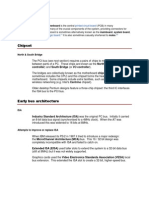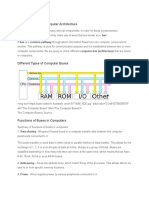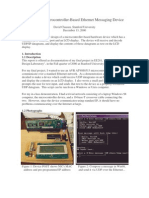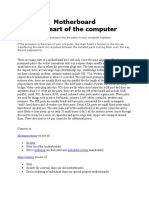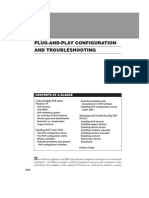100%(1)100% found this document useful (1 vote)
225 viewsIsa Bus
Isa Bus
Uploaded by
biotech_vidhyaThe Industry Standard Architecture (ISA) bus was the internal bus used in IBM PC-compatible computers from the first IBM PC in 1981 until the mid-1990s to connect the CPU to peripherals. It had an 8-bit data path that was expanded to 16-bits in 1984. By the late 1990s, ISA was replaced by faster peripheral component interconnect (PCI) buses due to ISA's slow speed and limited throughput.
Copyright:
© All Rights Reserved
Available Formats
Download as PPT, PDF, TXT or read online from Scribd
Isa Bus
Isa Bus
Uploaded by
biotech_vidhya100%(1)100% found this document useful (1 vote)
225 views30 pagesThe Industry Standard Architecture (ISA) bus was the internal bus used in IBM PC-compatible computers from the first IBM PC in 1981 until the mid-1990s to connect the CPU to peripherals. It had an 8-bit data path that was expanded to 16-bits in 1984. By the late 1990s, ISA was replaced by faster peripheral component interconnect (PCI) buses due to ISA's slow speed and limited throughput.
Original Description:
science
Original Title
ISA BUS
Copyright
© © All Rights Reserved
Available Formats
PPT, PDF, TXT or read online from Scribd
Share this document
Did you find this document useful?
Is this content inappropriate?
The Industry Standard Architecture (ISA) bus was the internal bus used in IBM PC-compatible computers from the first IBM PC in 1981 until the mid-1990s to connect the CPU to peripherals. It had an 8-bit data path that was expanded to 16-bits in 1984. By the late 1990s, ISA was replaced by faster peripheral component interconnect (PCI) buses due to ISA's slow speed and limited throughput.
Copyright:
© All Rights Reserved
Available Formats
Download as PPT, PDF, TXT or read online from Scribd
Download as ppt, pdf, or txt
100%(1)100% found this document useful (1 vote)
225 views30 pagesIsa Bus
Isa Bus
Uploaded by
biotech_vidhyaThe Industry Standard Architecture (ISA) bus was the internal bus used in IBM PC-compatible computers from the first IBM PC in 1981 until the mid-1990s to connect the CPU to peripherals. It had an 8-bit data path that was expanded to 16-bits in 1984. By the late 1990s, ISA was replaced by faster peripheral component interconnect (PCI) buses due to ISA's slow speed and limited throughput.
Copyright:
© All Rights Reserved
Available Formats
Download as PPT, PDF, TXT or read online from Scribd
Download as ppt, pdf, or txt
You are on page 1of 30
ISA BUS
(Industry Standard Architecture)
Cahit Tark Gen
What is BUS ?
A bus connects all the internal computer
components to the CPU and Main memory.
Every bus has a clock speed measured in
MHz. A fast bus allows data to be transferred
faster, which makes applications run faster.
On PCs, the old ISA bus is being replaced by
faster buses such as PCI.
I/O BUS
System Bus: Connecting to CPU, memory and Cache.
Address Bus
Data Bus
Control Bus
I/O Bus: Connecting to the above three buses is the "good old"
standard I/O bus, used for slower peripherals (mice, modems,
regular sound cards, low-speed networking) and also for
compatibility with older devices. On almost all modern PCs this is
the Industry Standard Architecture (ISA) bus.
Types of I/O Buses
ISA
Micro Channel (MCA)
EISA
VESA Local bus (VL-bus)
PCI Local bus
AGP
PC-Card (PCMCIA)
USB
Fire Wire (IEEE-1394)
I/O BUS
ISA BUS (8-16-bit)
EISA BUS (32-bit)
PCI BUS (32 or 64-bit)
AGP (32-bit)
ISA BUS
In 1982 when ISA BUS appeared on the first PC the
8-bit ISA bus ran at a modest 4.77 MHZ the same
speed as Intel 8088. ISA BUS is extremely slow by
today's standards and not suited to the use of a
graphical operating system like Windows.
ISA BUS
In 1984 the IBM AT was introduced using the Intel 80286;
at this time the bus was doubled to 16 bits (the 80286's data
bus width) and increased to 8 MHz (the maximum speed of
the original AT, which came in 6 MHz and 8 MHz versions
and 24 address lines).
ISA BUS
8-bit
16-bit
ISA BUS
Bus width 8 - bit
Compatible with 8 bit ISA
Pins 62
Power +5 V, -5 V, +12 V, -12 V
Clock 4.7727266 MHz
Bus width 16 - bit
Compatible with 16 bit ISA
Pins 98
Power +5 V, -5 V, +12 V, -12 V
Clock
8.333333 MHz
8-bit ISA BUS 16-bit ISA BUS
ISA BUS
is used with sound cards, disk drives or most
network and video cards.
8-bit ISA(XT) CARD 16-bit ISA CARD
ISA BUS
ISA Card
ISA BUS
Original 8 bit ISA
connectors
Additional
connections
converts to 16 bit
ISA
VESA connectors
ISA BUS
In the figure you can see the pinouts of
the ISA BUS. The BUS is divided into
two sides. The first side pins are named
A1 to A31 and it is the components side.
It consists of the address and data
buses. The second side pins are named
B1 to B31 and it is the solder side. This
side contents the power pins and the
signals related to interrupts and DMA
transfers.
ISA BUS
20 bits of Address bus
5, 12V
Power & G
IRQ lines
2-7
IRQ lines
8 - 15
Extra 8 bits of
I/O bus
Extra 4 bits of
Address bus
More
DMA
lines clock
Original 8 bit ISA 16 bit
More
DMA
lines
8 bits of I/O bus
ISA BUS
A0-A19 (pins A31 to A12): This twenty lines are the address BUS.They can address 1MB (2^20 bytes).
D0-D7 (pins A9 to A2): The data BUS consist of this eight data lines.
AEN (pin B11): It is used for the DMA controller to take over the data and address buses in a DMA
transfer.
GND (pins B1, B10, B31): Connected to the ground of the computer.
+5V (pins B3, B29): 5V DC output of the power source.
-5V (pin B5): -5V DC output.
-12V (pin B7): -12V DC output.
+12V (pin B9): +12V DC output.
MEMW (pin B11): The P asserts this signal when doing a write to the memory.
MEMR (pin B12): The P asserts this signal when doing a read from the memory.
IOW (pin B13): The P asserts this signal when doing a write to a port.
IOR (pin B14): The P asserts this signal when doing a read from a port.
DACK0-DACK3 (pins B15, B17, B19 and B26): The DMA controller sets this signals to let a device know
that the DMA has the control of the buses.
DRQ1-DRQ3 (pins B6, B16 and B18): Allow the peripheral boards to request the use of the buses.
+T/C (pin B27): The DMA controller sets this signal to let the peripheral know that the programmed
number of bytes has been sent.
IRQ2-IRQ7 (pins B4, B21, B22, B23, B24 and B25): Interrupt signals. The peripheral devices sets this
signals to request for the attention of the P.
ALE (pin 28): This signal is used for the P to lock the 16 lower address BUS in a latch during a memory
(or port) input/output operation.
CLOCK (pin 20): Is the system clock.
OSC (pin 30): Is a high frequency clock which can be used for the I/O boards.
Describing the Read operation of the ISA
CPU sends out a high on the
ALE signal, then sends out
the A0-A19 lines. On the
address of the target port to
be read will be latched. Then
the BUS takes the -IOR
signal to a low level. So that
the addressed device will
take a data byte to the D0-
D7 data bus. The
microprocessor will read then
the data bus and take the -
IOR signal to a high again.
Describing the Read/Write operation of the ISA
The only difference between a
memory read/write cycle and
a port read/write cycle is that
in a memory cycle the -MEMR
and -MEMW signals will be
asserted, working the same
way as -IOR and -IOW do.
ISA BUS
Intel
80386DX
CPU
Address bus(32 bit)
Data bus (32 bit)
A
0
to A
31
D
0
to D
31
RD WR IO/M
Control bus
I/O
bus
(16
bit
data)
Storage
Printer
Video
Modem
Memory
Keyboard
Bus Structure of Intel 486
CPU
Local bus or CPU bus: fast (33 MHz, 32 bits) [30 nsec./cycle]
Memory Cache
Video
Adapter
Disk
Expansion
Bus
Controller
RTC
ISA bus: slow (8 MHz, 8/16 bits) [125 nsec./cycle]
Keyboard
Serial
Port
Parallel
Port
Floppy
Disk
System
ROM
ISA BRIDGE
Bus Structure of Intel Pentium
Pentium
CPU
CPU bus: fast (100 MHz, 64 bits) [10 nsec./cycle]
Memory Cache
Video
Adapter
System
ROM
Expansion
Bus
Controller
RTC
ISA bus: slow (8 MHz, 8/16 bits) [125 nsec./cycle]
Keyboard
Serial
Port
Parallel
Port
Floppy
Disk
PCI
Controller
PCI bus: fast (33 MHz, 32/64 bits) [30 nsec./cycle]
Disk
North Bridge
South Bridge
Bus Structure of Intel Pentium
Expansion
Bus
Controller
M/IO #(memory
or i/o address)
D/C# (Data or code)
W/R# (Write or Read)
AEN#
A31-A3 (Address Lines)
BE7# - BE0# (Byte Enable
Lines)
CLK
BRDY# (Burst Ready)
CPU Bus PCI Bus
AD[31:0]
C/BE#[3:0]
FRAME#
TRDY#
IRDY#
STOP#
REQ#
GNT#
D31-D0
NORTH BRIDGE
Bus Structure of Intel Pentium
Expansion
Bus
Controller
CLK
MEMR#
MEMW#
IOR#
IOW#
INTA#
A23-A0
PCI Bus ISA Bus
AD[31:0]
C/BE#[3:0]
FRAME#
TRDY#
IRDY#
STOP#
REQ#
GNT#
D23-D0
SOUTH BRIDGE
ALE
ISA BUS INTERRUPT SYSTEM
16-bit ISA bus chains two 8259As together.
IRQ 9 is used to re-route anything trying to
use IRQ 2.
Incorporated in chip set.
INTERRUPT CONTROLLER
80x86
INTR
8259A
IRQ0
IRQ1
IRQ2
IRQ3
IRQ4
IRQ5
IRQ6
IRQ7
8259A
IRQ0 (8)
IRQ1 (9)
IRQ2 (10)
IRQ3 (11)
IRQ4 (12)
IRQ5 (13)
IRQ6 (14)
IRQ7 (15)
(IRQ 2)
Elimination of ISA Bus
ISA Bus is slow, hard to use and bulky.
ISA plug in cards to be replaced by either PCI
plug-in cards or USB add-on peripherals
Limited number of interrupts.
No central registry.
Elimination of ISA Bus
The ISA bus is limited to 24 bits of
address. 2^24 = 16 MBytes. It means that
an ISA card that uses DMA cannot
physically access memory beyond 16
MBytes of RAM. This is a limitation of the
ISA bus.
Elimination of ISA Bus
Motherboard gets 32-bit data from ISA BUS
at two times. Meanwhile at this time ISA BUS
declares wait state to the motherboard.
Therefore ISA BUS may reduce System
Performance.
Elimination of ISA Bus
If you use a ISA based controller card such
as Ultra SCSI - 40Mb / sec or
SCSI-2 Fast - 10 Mb / sec , you can expect
no more than an 8Mb per second transfer
rate from your controller card.
Elimination of ISA Bus
PCI cards have Plug and Play technology
and can configure themselves, so Operating
Systems distinguish them.
ISA cards are more cumbersome to install
than other cards because I/O addresses,
interrupts and clock speed must be set using
jumpers and switches on the card itself.
Elimination of ISA Bus
Bus Type MB/sec
VL-bus 100 MBps
VL-bus 132 MBps
32-Bit PCI 132 MBps
PCI-X 66 512 MBps
PCI-X 133 1 GBps
AGP x1 264 MB/s
AGP x2 528 MB/s
AGP x4 1056 MB/s
AGP x8 2112 MB/s
PCI Express x1 500 MB/s
PCI Express x2 1000 MB/s
PCI Express x4 2000 MB/s
PCI Express x8 4000 MB/s
PCI Express x12 6000 MB/s
PCI Express x16 8000 MB/s
You might also like
- Presentation 17 - Buses: PC FundamentalsDocument32 pagesPresentation 17 - Buses: PC Fundamentalsindranijagrati100% (1)
- Computer MotherboardDocument54 pagesComputer Motherboardrandex3r100% (2)
- Motherboard ArchitectureDocument15 pagesMotherboard ArchitectureAbhishek DebNo ratings yet
- I O and The South BridgeDocument5 pagesI O and The South BridgeMarceloNo ratings yet
- School Management System": Title of The ProjectDocument19 pagesSchool Management System": Title of The Projectvijay RajputNo ratings yet
- Chap15 Lect13 BusDocument20 pagesChap15 Lect13 BusparveenthakNo ratings yet
- ISA and PC104 Bus DescriptionDocument20 pagesISA and PC104 Bus DescriptionUsamaNo ratings yet
- Introduction To The I/O Buses: Functions of Buses in ComputersDocument12 pagesIntroduction To The I/O Buses: Functions of Buses in ComputersrubinderNo ratings yet
- MotherboardDocument4 pagesMotherboardMary Ann BalauitanNo ratings yet
- ISA BUS RaporuDocument10 pagesISA BUS Raporuravi02431No ratings yet
- MCA Bus OperationsDocument10 pagesMCA Bus OperationsDrift GeeNo ratings yet
- Lectures 5-8 Types of BusesDocument17 pagesLectures 5-8 Types of BusesaaaaNo ratings yet
- The Motherboard: Form Factors Chipsets Connectors Buses MotherboardDocument48 pagesThe Motherboard: Form Factors Chipsets Connectors Buses MotherboardWilbertJamesEscletoMoralesNo ratings yet
- Introduction To The I/O Buses Technical and Historical Background For The I/O BusesDocument9 pagesIntroduction To The I/O Buses Technical and Historical Background For The I/O BusesshankyguptaNo ratings yet
- Chapter Two Hardware SoftwareDocument24 pagesChapter Two Hardware SoftwaressebunyaNo ratings yet
- Types of BusesDocument16 pagesTypes of BusesIan Conan JuanicoNo ratings yet
- Chapter Seven Bus and Cards Bus: Processor-Memory Bus (May Be Proprietary)Document10 pagesChapter Seven Bus and Cards Bus: Processor-Memory Bus (May Be Proprietary)minichelNo ratings yet
- Buses SPR 2001 Ajit UmraniiDocument14 pagesBuses SPR 2001 Ajit UmraniiAviraj GhanekarNo ratings yet
- CHN EXPDocument32 pagesCHN EXPAnanduNo ratings yet
- CSC 1020 - Computer BusesDocument11 pagesCSC 1020 - Computer BusesarnoldnsondojrNo ratings yet
- Motherboard: The CPUDocument10 pagesMotherboard: The CPU000pssNo ratings yet
- EE6304 Lecture14 Buses (1) 1Document63 pagesEE6304 Lecture14 Buses (1) 1Ashish SoniNo ratings yet
- Diagram of Bus ControllerDocument7 pagesDiagram of Bus ControllerGhanshyam Kashyap100% (1)
- Expansion SlotsDocument6 pagesExpansion SlotsMahesh Abnave0% (1)
- Bus StandardsDocument13 pagesBus StandardsPrasad SP0% (1)
- Parts of The Motherboard: Ashley Abogado Computer 10Document4 pagesParts of The Motherboard: Ashley Abogado Computer 10DeathNo ratings yet
- Unit-5: Types of Buses in Computer ArchitectureDocument19 pagesUnit-5: Types of Buses in Computer ArchitectureEphrage GurureNo ratings yet
- BIOS or Basic Input Output SystemDocument13 pagesBIOS or Basic Input Output SystemSaymon Casilang SarmientoNo ratings yet
- Identifying Motherboard Hardware Parts and Its FunctionDocument14 pagesIdentifying Motherboard Hardware Parts and Its FunctionBrenda Macanlalay Asuncion80% (5)
- PC InterfaceDocument50 pagesPC InterfacechiropriyacNo ratings yet
- The Motherboard Is Considered As The Main Circuit BOARDDocument8 pagesThe Motherboard Is Considered As The Main Circuit BOARDJoraynie Dag-uman MercadoNo ratings yet
- E. PC Bus ArchitecturesDocument15 pagesE. PC Bus Architecturesgraceangia2No ratings yet
- Design of A Microcontroller-Based Ethernet Messaging DeviceDocument45 pagesDesign of A Microcontroller-Based Ethernet Messaging Devicedan_arcana100% (1)
- PC Hardware and Inside The BOXDocument48 pagesPC Hardware and Inside The BOXash245No ratings yet
- Bus Standards NotesDocument34 pagesBus Standards NotesKaushik MuralidharanNo ratings yet
- Name: Mohamed Hardi Lafou: A Brief DescriptionDocument4 pagesName: Mohamed Hardi Lafou: A Brief DescriptionmohaNo ratings yet
- Passing Package CSDocument20 pagesPassing Package CSbharathkumar900845No ratings yet
- ReportDocument8 pagesReportapi-3734554100% (1)
- Motherboard The Heart of The Computer: Microprocessors Sockets Soldering Embedded System Main MemoryDocument8 pagesMotherboard The Heart of The Computer: Microprocessors Sockets Soldering Embedded System Main MemoryJhay Consolacion WalkerNo ratings yet
- HardDisk NotesDocument5 pagesHardDisk NotesSudeep OnemNo ratings yet
- Lecture 8 - IO BusesDocument70 pagesLecture 8 - IO BusesHydie CruzNo ratings yet
- ARM MBED Board (LPC1768) - MBEDDocument4 pagesARM MBED Board (LPC1768) - MBEDKrishanu Modak100% (1)
- PC TroubleshootingDocument112 pagesPC TroubleshootingMosul VictoriaNo ratings yet
- MotherboardDocument15 pagesMotherboardDragoon GamingNo ratings yet
- Computer Bus Architecture: Von Neumann Computer ModelDocument19 pagesComputer Bus Architecture: Von Neumann Computer ModelJoshua AyoolaNo ratings yet
- CSE3117-Lecture 2-Microprocessor Based PCDocument27 pagesCSE3117-Lecture 2-Microprocessor Based PCABU DOJANANo ratings yet
- HW Specification ch5-7Document28 pagesHW Specification ch5-73d nat natiNo ratings yet
- Week 4:: Computer Interconnection Structures, Bus Interconnection, PCIDocument16 pagesWeek 4:: Computer Interconnection Structures, Bus Interconnection, PCIRegji IndonNo ratings yet
- Identifying Motherboard Hardware Parts and Its FunctionDocument31 pagesIdentifying Motherboard Hardware Parts and Its FunctionNhil Cabillon Quieta100% (1)
- Hardware&Networking Manual 231124 165519Document46 pagesHardware&Networking Manual 231124 165519crecbhoomi21No ratings yet
- Unit - III - Interfacing: Anusha.K Ap, SiteDocument26 pagesUnit - III - Interfacing: Anusha.K Ap, SiterajgantNo ratings yet
- Introduction To Embedded System I/O Architectures and BusesDocument20 pagesIntroduction To Embedded System I/O Architectures and BusesSamar PratapNo ratings yet
- Motherboard Components... CSEDocument28 pagesMotherboard Components... CSEAtulay Mahajan50% (2)
- Aim: Introduction To Computer Hardwares Steps:-: TIME-80 Mins (02 PDS)Document15 pagesAim: Introduction To Computer Hardwares Steps:-: TIME-80 Mins (02 PDS)VanessaNo ratings yet
- PC CardsDocument11 pagesPC CardsjisskuruvillaNo ratings yet
- Computer System Expansion SlotsDocument5 pagesComputer System Expansion SlotsMary Millare100% (1)
- Module 3Document10 pagesModule 3Smitha RajeshNo ratings yet
- Interfacing With The ISA BusDocument12 pagesInterfacing With The ISA BusseyfiNo ratings yet
- Mega Drive Architecture: Architecture of Consoles: A Practical Analysis, #3From EverandMega Drive Architecture: Architecture of Consoles: A Practical Analysis, #3No ratings yet
- Master System Architecture: Architecture of Consoles: A Practical Analysis, #15From EverandMaster System Architecture: Architecture of Consoles: A Practical Analysis, #15Rating: 2 out of 5 stars2/5 (1)
- Radio Shack TRS-80 Expansion Interface: Operator's Manual: Catalog Numbers: 26-1140, 26-1141, 26-1142From EverandRadio Shack TRS-80 Expansion Interface: Operator's Manual: Catalog Numbers: 26-1140, 26-1141, 26-1142No ratings yet
- Q.No. Type Section Key/Range MarksDocument3 pagesQ.No. Type Section Key/Range Marksbiotech_vidhyaNo ratings yet
- BT 2019Document13 pagesBT 2019biotech_vidhyaNo ratings yet
- Buffer Preparation PDFDocument6 pagesBuffer Preparation PDFbiotech_vidhyaNo ratings yet
- Troubleshooting SDS-PAGE 1Document3 pagesTroubleshooting SDS-PAGE 1biotech_vidhyaNo ratings yet
- Buffer Preparation PDFDocument6 pagesBuffer Preparation PDFbiotech_vidhyaNo ratings yet
- Polymerase Chain Reaction (PCR)Document3 pagesPolymerase Chain Reaction (PCR)biotech_vidhyaNo ratings yet
- TNPSC Group 1 Prelim Book List PDFDocument2 pagesTNPSC Group 1 Prelim Book List PDFbiotech_vidhyaNo ratings yet
- Whole Cell ExtractDocument1 pageWhole Cell Extractbiotech_vidhyaNo ratings yet
- Nuclear ExtractsDocument2 pagesNuclear Extractsbiotech_vidhyaNo ratings yet
- TNPSC Group 1 Prelim Book List PDFDocument2 pagesTNPSC Group 1 Prelim Book List PDFbiotech_vidhyaNo ratings yet
- Ies 17 Set A Me Q ADocument67 pagesIes 17 Set A Me Q Abiotech_vidhyaNo ratings yet
- Mechanical Engineering Code No. 14: Combined Competitive (Preliminary) Examination, 2010Document20 pagesMechanical Engineering Code No. 14: Combined Competitive (Preliminary) Examination, 2010biotech_vidhyaNo ratings yet
- 1 TolerancesDocument1 page1 Tolerancesbiotech_vidhyaNo ratings yet
- Teachers Recruitment Board: 1. Important DatesDocument13 pagesTeachers Recruitment Board: 1. Important Datesbiotech_vidhyaNo ratings yet
- Befcv List PDFDocument22 pagesBefcv List PDFbiotech_vidhyaNo ratings yet
- Lec09 Three PhaseDocument84 pagesLec09 Three Phasebiotech_vidhyaNo ratings yet
- Plug and PlayDocument28 pagesPlug and PlayDrift GeeNo ratings yet
- Computer System, HardwareDocument201 pagesComputer System, Hardwareapi-3833170No ratings yet
- CSC 1020 - Computer BusesDocument11 pagesCSC 1020 - Computer BusesarnoldnsondojrNo ratings yet
- 5th 2023Document554 pages5th 2023MD Anis MiaNo ratings yet
- Interconnection StructuresDocument43 pagesInterconnection Structuresaryans1489% (36)
- Motherboards: in This Chapter, You Will LearnDocument46 pagesMotherboards: in This Chapter, You Will LearnBif FlaviusNo ratings yet
- Generation of ComputerDocument150 pagesGeneration of ComputerYzon Fabriag100% (1)
- Dos and Don'ts of Deploying NVMe Over Fabrics BRKDCN-3677 2023Document453 pagesDos and Don'ts of Deploying NVMe Over Fabrics BRKDCN-3677 2023James Zhang100% (1)
- Types of BusesDocument16 pagesTypes of BusesIan Conan JuanicoNo ratings yet
- Data Acquisition SystemsDocument16 pagesData Acquisition SystemsManiraj PerumalNo ratings yet
- Timeline of The History of ComputersDocument5 pagesTimeline of The History of ComputersEden Ghie Briones - BanoNo ratings yet
- Grafička Kartica: Tehnička Škola Kikinda Elektrotehničar RačunaraDocument18 pagesGrafička Kartica: Tehnička Škola Kikinda Elektrotehničar RačunaraНемања ПоповићNo ratings yet
- MCA Bus OperationsDocument10 pagesMCA Bus OperationsDrift GeeNo ratings yet
- Introduction To The PCDocument61 pagesIntroduction To The PCLucia ErhanNo ratings yet
- MCAlink User's ManualDocument12 pagesMCAlink User's ManualAhmadou Yerima AbbaNo ratings yet
- Ahmed: 1-AYAS-FFL-002-EG: Egyptian: Cairo, Egypt: Name Code Nationality Current LocationDocument5 pagesAhmed: 1-AYAS-FFL-002-EG: Egyptian: Cairo, Egypt: Name Code Nationality Current Locationa.elcobtanNo ratings yet
- Linux Configuration and InstallationDocument426 pagesLinux Configuration and InstallationAkop KarapetyanNo ratings yet
- Istilah Dalam KomputerDocument7 pagesIstilah Dalam KomputerSyahid DerlauwNo ratings yet
- Unit-5: Types of Buses in Computer ArchitectureDocument19 pagesUnit-5: Types of Buses in Computer ArchitectureEphrage GurureNo ratings yet
- Introduction To Computer Architecture, Software Engineering and SystemsDocument55 pagesIntroduction To Computer Architecture, Software Engineering and SystemsBASS BOOSTEDNo ratings yet
- Appendixf (PC Error Codes Beeps and Diagnostic Message)Document34 pagesAppendixf (PC Error Codes Beeps and Diagnostic Message)NaeemSiddiquiNo ratings yet
- Local Area Network (LAN) Compatibility Issues.: Espiritu, Rita VDocument105 pagesLocal Area Network (LAN) Compatibility Issues.: Espiritu, Rita VAbdelkaderBenbadaNo ratings yet
- Microchannel Coil Technology & Its BenifitsDocument2 pagesMicrochannel Coil Technology & Its BenifitsPawan SehrawatNo ratings yet
- Computer Architecture: Biyani's Think TankDocument26 pagesComputer Architecture: Biyani's Think Tanksauravv7No ratings yet
- List of Intel ChipsetsDocument29 pagesList of Intel ChipsetsVikas SainiNo ratings yet
- Module 4-Motherboard.18214342Document59 pagesModule 4-Motherboard.18214342Fercie Q. EngresoNo ratings yet
- Isa BusDocument30 pagesIsa Busbiotech_vidhya100% (1)
- Unit 1 Inside The PC Core ComponentsDocument85 pagesUnit 1 Inside The PC Core Componentskasyap raut100% (2)
- Full Form of ITDocument4 pagesFull Form of ITsuryansh1234No ratings yet








